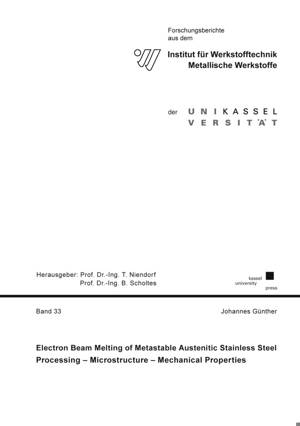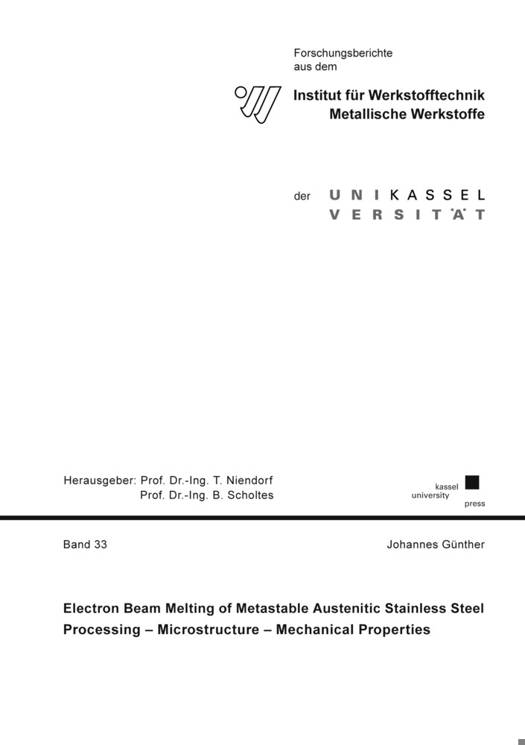
- Afhalen na 1 uur in een winkel met voorraad
- Gratis thuislevering in België vanaf € 30
- Ruim aanbod met 7 miljoen producten
- Afhalen na 1 uur in een winkel met voorraad
- Gratis thuislevering in België vanaf € 30
- Ruim aanbod met 7 miljoen producten
Zoeken
Electron Beam Melting of Metastable Austenitic Stainless Steel
Processing - Microstructure - Mechanical Properties
Johannes Günther
Paperback | Engels | Forschungsberichte aus dem Institut für Werkstofftechnik, Metallische Werkstoffe der Universität Kassel | nr. 33
€ 38,45
+ 76 punten
Omschrijving
Electron beam melting (EBM) is a powder-bed based additive manufacturing (AM) process suitable for the production complex metallic components. It is based on a layer-wise built-up of parts by a successive melting of powder-layers according to the cross-sections provided by a CAD design. Compared to other AM technologies it is advantageous in terms of residual stress formation, part distortion or cracking in non-weldable alloys due to the elevated process temperatures. Moreover, the vacuum atmosphere, demanded for the application of the electron beam (EB) as heat source, is beneficial for the fabrication of materials with high chemical reactivity or affinity to oxygen. Though, similar to the laser powder-bed fusion AM technologies, EBM is confronted with certain drawbacks that could possibly impede further exploitation. Among these are, for example, a limited material portfolio or availability of comprehensive closed-loop process monitoring systems, which would enhance reliability of the process. Furthermore, certain issues regarding the performance of material have to be addressed. This refers to an intrinsic high surface roughness, process-induced inhomogeneities and the formation of strong crystallographic textures, which potentially have a detrimental effect on mechanical behavior and isotropy of properties, respectively. These aspect are comprehensively discussed in a literature review containing severalresults obtained by the author, which contribute to a deeper understanding of the fatigue behavior of SLM as well as EBM manufactured Ti-6Al-4V. For the sake of readability and the structure of the present dissertation, the main findings of the studies are summarized within the theoretical foundations. They are revisited in the results section as they are essential for a comprehension of the outstanding characteristics of the investigated alloy. The primary focus of this work is theprocessing - microstructure - property correlation of EBM manufactured high-alloyed austenitic CrMnNi stainless steel. Independent of the applied process parameters, to this point this alloy exhibits a fine-grained and weak textured microstructure in the as-built state upon EBM processing. As detailed in the literature review, this is opposite to numerous alloys like the benchmark AISI 316L stainless steel, which are commonly characterized by epitaxial growth of columnar grains elongated parallel to building direction. A theory for this unusual observation is presented based on a grain refinement due the process-inherent cyclic heat-treatment, i.e. repetitive reheating and partial melting of the consolidated material due to the energy input during melting of subsequent layers and resulting solid-liquid as well as solid-solid (ferritic bcc to austenitic fcc phase and vice versa) phase transformations. A calculation of the phase diagram, differential thermal II Abstract analysis and the investigation of the uppermost layers of bulky and thin-walled EBM processed structures are conducted to support this assumption. Moreover, the CrMnNi stainless steel specimens are characterized by an outstanding damage tolerance, which is demonstrated by tensile testing and examination of the fracture surfaces revealing large lack-of-fusion defects due to unsuitable process parameters. Combined EBSD and X-ray diffraction analysis attribute the high damage tolerance to a pronounced strain hardening and mitigation of the effect of defects due to the transformation-induced plasticity (TRIP) effect. The deformation-induced martensitic transformation and associated strain hardening has also been correlated to a considerable low-cycle fatigue performance even under the presence of large inhomogeneities.The chemical composition of the alloy upon EBM processing is strongly dependent on the process parameters, i.e. it is demonstrated that the evaporation rate of Mn varies with the scan strategy and volumetric energy density. This phenomenon is utilized for the fabricatio
Specificaties
Betrokkenen
- Auteur(s):
- Uitgeverij:
Inhoud
- Aantal bladzijden:
- 149
- Taal:
- Engels
- Reeks:
- Reeksnummer:
- nr. 33
Eigenschappen
- Productcode (EAN):
- 9783737608480
- Uitvoering:
- Paperback
- Afmetingen:
- 148 mm x 9 mm
- Gewicht:
- 224 g

Alleen bij Standaard Boekhandel
+ 76 punten op je klantenkaart van Standaard Boekhandel
Beoordelingen
We publiceren alleen reviews die voldoen aan de voorwaarden voor reviews. Bekijk onze voorwaarden voor reviews.








